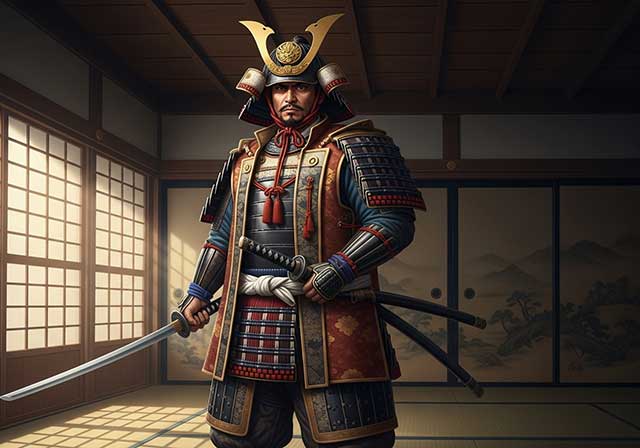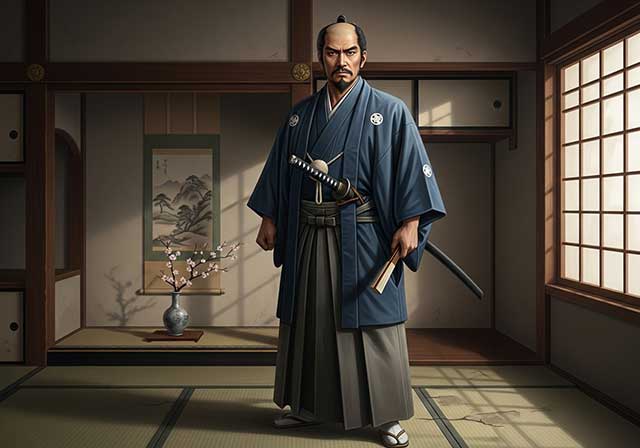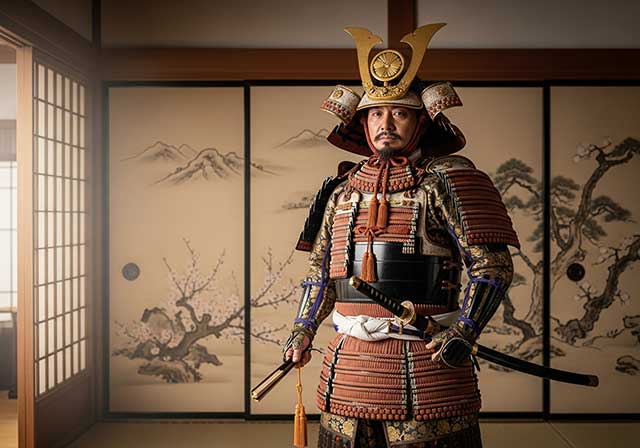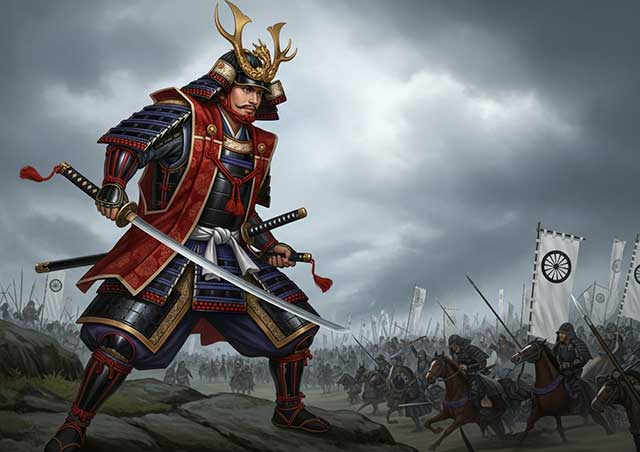
Ōtomo Yoshishige came from a noble lineage, being the eldest son of Ōtomo Yoshiaki, the ruler of Funai Province. The roots of the Ōtomo family traced back to Fujiwara Hidesato, the adopted son of Nakahara Chikayoshi. Fujiwara served Minamoto Yoritomo during the Genpei War and took part in battles in Mutsu Province in 1189. In 1193, he was appointed shugo of Buzen and Bungo Provinces, after which he adopted a new surname—Ōtomo.
Rise of Ōtomo Yoshishige
In 1550, Ōtomo Yoshiaki was killed by his vassal Tsukuni Mimasaka. After his death, Ōtomo Yoshishige became the twenty-first head of the clan. He showed natural leadership and began expanding the clan’s lands on Kyushu. In 1551, he suppressed the rebellion of Kikuchi Yoshimune in Higo Province. In 1557, he invaded Chikuzen Province and subjugated Akizuki Kiyotane. In 1559, he organized a successful attack that allowed the clan to retake Moji Castle, previously seized by the Mori clan. However, Mori forces soon recaptured the castle, and a later attempt in 1561, even with Portuguese naval support, failed.
The Adoption of the Name Sōrin and Early Alliances
In 1562, Yoshishige adopted the name Sōrin, by which he is best known. That same year he formed an alliance with the Mori clan’s enemies—the Amako clan—and launched an offensive against Mori fortifications in Buzen Province. A peace agreement was reached thanks to the mediation of Shogun Ashikaga Yoshiteru. According to the terms, one of Sōrin’s daughters was to marry Mori Terumoto, though it remains unclear whether the marriage ever took place.
Confrontation with Ryūzōji and Expansion of Influence
In 1568, Ōtomo began a war against the Ryūzōji clan of Hizen Province, a move that in practice struck at Mori influence. Yet Ōtomo vassal Hetsugi Akitsura was defeated by Mori forces in the 1569 Battle of Tatarahama, losing Tachibana Castle. In response, Sōrin attacked Mori positions in Buzen, forcing them to retreat. After these events, Sōrin effectively controlled Bungo, most of Buzen, Chikuzen, Chikugo, and held significant influence in Higo and Hizen. Ōtomo banners even flew over castles in Iyo Province, captured from the Kōno clan. His army became known as “Ōtomo Shichikakoku no Zei”—the Army of the Seven Provinces.
Internal Weaknesses of the Clan
Despite his power on paper, Sōrin remained vulnerable. The main obstacles to his ambitions were the lack of unity among his vassals and the threat posed by the strong Shimazu clan. Some lineages, such as Tachibana and Tamura, maintained significant independence and were not true vassals in the full sense, hindering Sōrin’s ability to enforce total control like a successful Sengoku-era daimyo.
Christianity and Internal Conflict
In 1551, Sōrin welcomed Francis Xavier and permitted the establishment of a Jesuit mission in Bungo. He treated Christian missionaries favorably—perhaps due to the weapons and trade opportunities Europeans offered, though personal influence of the religion cannot be dismissed. However, his support for Christianity sparked discontent: his wife strongly opposed it, and many vassals were angered by missionary activities, especially the desecration of Buddhist and Shinto temples. Despite this, Sōrin continued to support the missionaries and in 1575 had his son baptized. In 1578, he divorced his wife and was baptized himself, taking the Christian name Francisco. Two years earlier he had transferred power to his son Yoshimune, who bore the Christian name Constantine.
Invasion of Hyūga and the Shimazu Conflict
The situation shifted when the Shimazu clan destroyed the Itō clan, forcing Itō Yoshisuke to seek refuge with Ōtomo. Yoshimune decided to launch an invasion of Hyūga Province before the Shimazu could unite their forces. Eager to prove himself as clan leader, he ignored warnings from his vassals that such a campaign would provoke other enemies. He raised an army of about forty thousand warriors and marched into Hyūga. Sōrin accompanied him, planning to found a new Christian city there.
Early Victories and Fatal Mistakes
Their first obstacle was Matsuo Castle, commanded by Tsuchimochi Chikanari—a capable general who had once served the Itō but later defected to the Shimazu. The Ōtomo army defeated Tsuchimochi and annexed his lands, where Sōrin and Yoshimune began destroying local Buddhist and Shinto temples, provoking anger among locals and their own vassals.
The main forces were placed under Tawara Chikataka, Sōrin’s half-brother. Tawara crossed the Omaru River and stopped at Taka Castle, defended by three thousand warriors under the experienced Shimazu Iehisa. Tawara made a critical mistake: he chose to bypass the castle, leaving only a small blocking force, and underestimated the Shimazu commanders. Meanwhile, Shimazu Yoshihisa executed a series of maneuvers that culminated in the Battle of Mimigawa. The battle ended in a disastrous defeat for the Ōtomo: thousands were killed, thousands fled.
Decline of the Ōtomo Clan
Sōrin and his son retreated to Bungo in deep despair. Fortune had abandoned the clan. The next year they lost Chikugo to the Ryūzōji. A new rebellion by Akizuki Tanezane broke out. Unrest also spread in Bungo due to continued support for Christian missions. The Ōtomo position became so weak that the Shimazu offered a cease-fire, which the clan accepted immediately. This allowed the Shimazu to turn their focus toward their more dangerous enemy—Ryūzōji Takanobu.
Last Hope: Alliance with Hideyoshi
In 1586, the Ōtomo’s misfortunes reached their peak. After the death of Ryūzōji Takanobu in battle with the Shimazu, Yoshihisa turned his attention to Bungo. In May, Sōrin left his residence in Usuki and traveled to Osaka to plead with Toyotomi Hideyoshi for protection. Hideyoshi already planned to conquer Kyushu, and Sōrin’s request provided the perfect justification.
In December, the first corps of Hideyoshi’s army landed on Kyushu and joined forces with Ōtomo Yoshimune. Although the combined forces were defeated in the Battle of Hetsugigawa, Hideyoshi’s massive main army, following close behind, drove the Shimazu back to Satsuma.
The End of Clan Independence
Sōrin died soon after the defeat of the Shimazu. Although the Ōtomo lands were once again safe, the clan lost its independence forever.
Zobacz także
-
Okudaira Sadamasa

Sadamasa was the son of Okudaira Sadayoshi and took part in several battles under Tokugawa Ieyasu, distinguishing himself in the Battle of Anegawa in 1570, where he took two heads. Around 1572 he was forced to enter the service of the Takeda clan, but after the death of Takeda Shingen in 1573 he returned to Tokugawa, leaving Tsukude Castle together with his men. As a result of this defection, Takeda Katsuyori ordered the execution of Sadamasa’s wife and brother, who were being held as hostages.
-
Okubo Tadatika

Tadatika, the son of Okubo Tadayō, entered the service of Tokugawa Ieyasu at the age of eleven, and took his first head in battle when he was sixteen. After the establishment of the Tokugawa shogunate, he was appointed as a rōjū — a senior bakufu official — and was regarded as one of Ieyasu’s most trusted advisors, alongside Honda Masanobu. He is also known for his military chronicle Mikawa Monogatari, which describes Ieyasu’s rise to power and the early years of the Tokugawa shogunate.
-
Okubo Nagayasu

Nagayasu was the second son of Okura Nobuyasu, a sarugaku theater actor from the Takeda clan. Takeda Shingen recognized the young man’s potential and took him into service, appointing him as a vassal to his general, Tsuchiya Masatsugu. During this period, Nagayasu changed his family name to Tsuchiya. He was entrusted with developing the Takeda clan’s gold mines as well as handling matters related to taxation.
-
Nitta Yoshisada

Nitta Yoshisada was a loyal soldier of Emperor Go-Daigo, who in the 1330s attempted to restore direct imperial rule in Japan. The Nitta family was related to the Ashikaga house and was older in lineage. However, they did not join Minamoto Yoritomo at the start of his war with the Taira, as the Ashikaga did, and therefore did not receive high positions in the Kamakura shogunate. This may have been one of the reasons why Yoshisada rose against the Hōjō clan in 1333.
-
Natsume Yoshinobu

Yoshinobu, a long-time vassal of the Matsudaira and Tokugawa clans, governed Hamamatsu Castle on behalf of the Tokugawa house. During the clashes between the Imagawa, Takeda, and Matsudaira clans, he served in the garrison of Nagasawa Castle and in 1562 took part in raids under the command of Itakura Shigezane. When, in 1563, a revolt of the Sōtō-shū sect followers broke out in Mikawa Province, Yoshinobu joined the rebels together with Honda Masanobu and Hachiya Sadatsugu.
-
Nambu Nobunao

The Nambu clan was an ancient and powerful family that traced its lineage back to the Minamoto shoguns and had controlled a significant part of the Tohoku region in northern Honshu since the 12th century. Nobunao was born in Ikatai Castle, located in what is now the city of Iwate. He was the second son of Ishikawa (Nambu) Takanobu, the 22nd head of the Nambu clan. In 1565, Nobunao’s uncle, Nambu Harumasa, adopted him, brought him to Sannohe Castle, and named him his heir, later giving his daughter in marriage to him.
-
Naito Ienaga

Ienaga was the son of Naitō Kiyonaga and served Tokugawa Ieyasu from an early age. Like his father, he was exceptionally brave, and thanks to his remarkable skill with the bow, he earned the nickname “the unrivaled archer.” Although both the elder and the younger Naitō belonged to the Jōdo Shinshū (“True Pure Land”) sect, during the Ikkō-ikki uprising in Mikawa Province in 1565, Ienaga did not support his fellow believers and instead sided with Tokugawa Ieyasu, earning his special trust. He later took part in the battles of Mikatagahara, Nagashino, and many other engagements while accompanying Ieyasu.
-
Minamoto no Yoshitsune

Minamoto no Yoshitsune was the son of Minamoto no Yoshitomo and his second wife, Tokiwa Gozen, as well as the younger half-brother of Minamoto no Yoritomo, the founder of the first shogunate, who had once suffered defeat in the struggle against the Taira clan. Yoshitsune spent his childhood in exile at the Kuramayama Temple. According to legend, he studied not so much Buddhist sutras there as the arts of war. At the age of fifteen, he entered the service of the governor in Mutsu, Fujiwara Hidehira.

